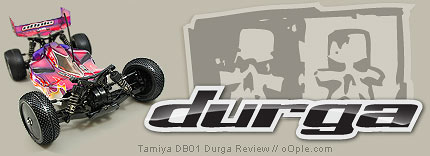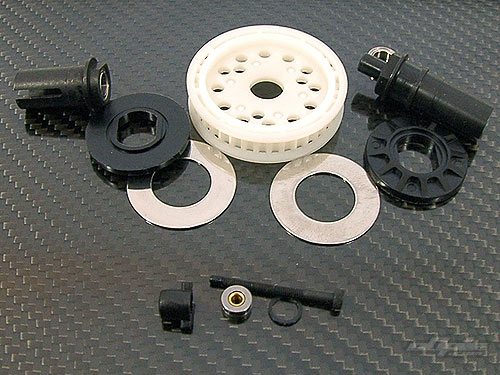
|
The next step is to build both front & rear differentials. These are identical ball-type units at either end, and use the large 37T pulleys from the worlds-spec TRF 501X. The rest of the differentials are sadly not up to the spec of the 501X however, and feature half-plastic differential halves (similar to those seen on the DF03 chassis cars).
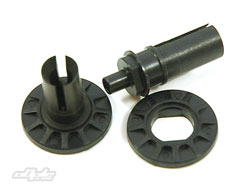
|
The manual suggests using ‘rubber cement’ to glue the diff rings to the plastic holder. I confess I have no real idea what ‘rubber cement’ is – so I did what I did on the DF03 Keen Hawk, and used some thin CA glue that I have lying around for gluing tyres.
|
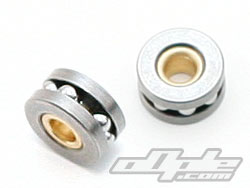 |
I don’t like the idea of these rings slipping on the plastic holders and potentially messing things up. You could build it like a ‘normal’ diff without any glue at all, but I chose this method. It’s a good idea to clean the diff rings to remove any oils prior to assembly, which could potentially cause problems later.
The assembled diffs feel rather good I have to say (must be the mechanic? Hehe), not quite as good as the 501X however, with a very slightly tight spot - and their longevity remains to be seen. I confess I don’t really ‘get’ the half-plastic construction – sure it’s to save money, but it just seems a bad idea to skimp on something as crucial as the differentials. 
Right: pre-assembled 'thrust races' feature on the Durga diffs' |
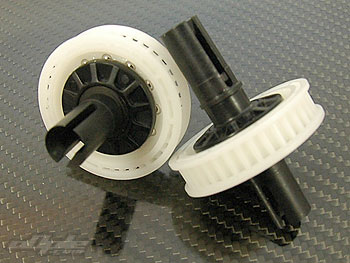 |
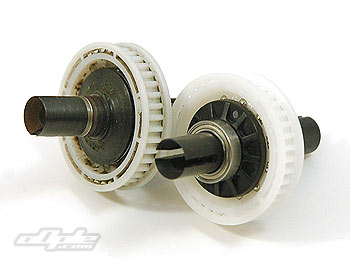 |
| The completed differentials are identical and feel GOOD despite the relatively cheap construction. |
Right: 501X Differential - Left: Durga Differential ..... Hopefully the Durgas sealed drivetrain will help keep the differentials clean and smooth running. |
|
The front and rear shock towers are moulded plastic composite items. Thankfully Tamiya have again used a hard composite plastic here which drasticly cuts down on flex compared to their other budget cars, and along with the sheer thickness of the construction should see these towers take some decent hits.
The front and rear gearbox tops are identical and the shock towers attach directly to these. The shock towers are a totally different design to the TRF car, but mimic the essential geometry, albeit in a chunky plastic. |
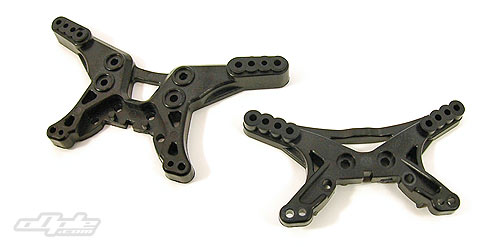 |
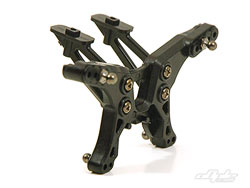 |
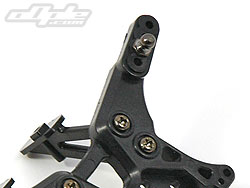 |
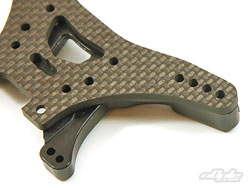 |
Wing mounts are moulded from softer plastic than the rest of the parts - to absorb impacts. |
The dampers attach to ball studs all round on the Durga. It's quick and easy to remove the shocks for maintenance. |
The 501X shock towers can't be used, but the shock mounting holes are the same. The DB01 towers also carry the camber links. |
|
The shock towers mount to the gearbox tops with four screws each, and the towers wrap around their respective mounting locations to give a very sturdy feel. The holes in the gearbox tops certainly need pre-tapping if you’re using the kit screws.
Body posts need to be attached to the gearbox tops now since they can’t be fitted once the car is assembled. I chose not to install body posts since I’ll be using Velcro to attach the bodyshell for a cleaner look. |
The Durga’s differentials mount in eccentric bearing sleeves, which can be turned one ‘notch’ at a time to set belt tension by moving the differential fore or aft. The durga goes one step extra and here the eccentric sleeves mount into their own gearbox mounts – setting the diff position / belt tension prior to installing in the car.
It isn’t always easy to set belt tension in the 501X, since turning the eccentric sleeves and lining them up the same either side can be tricky especially without good lighting. So by forcing the user to take the differentials completely out and adjusting the sleeves one at a time in their mounts will surely make for more accurate settings and less problems for the novice user the Durga is aimed at. |
With the rear differential installed in the chassis, the rear gearbox top can be installed – but first a ‘belt tunnel’ is pressed into the chassis. This isn’t as much use on the rear of the car but can be used for routing wires etc. At the front, the steering assembly will operate through this area.
The belt tunnel has a small tab which shows which way it should be inserted. It's a fairly tight fit in the gearbox top and care is needed not to knock the diff' out of alignment when putting on the gearbox tops. |
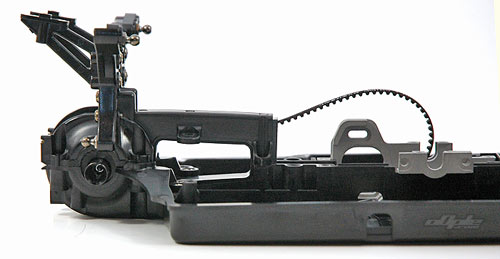 |
|
